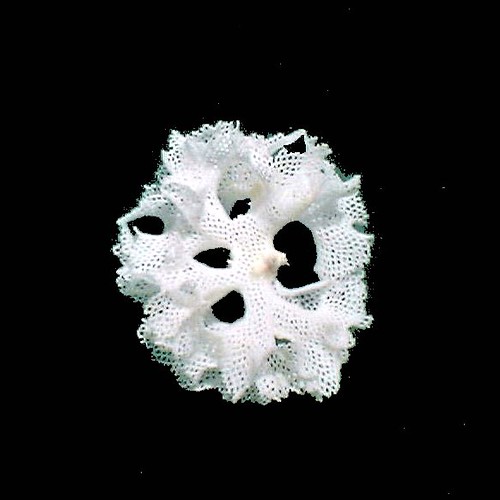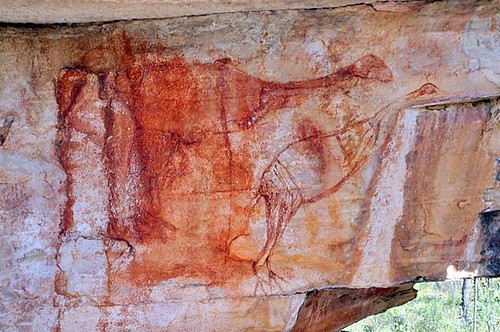Hm. You know, something’s not right here. That logo could use a little something... extra. (Click to enlarge.)
There. That’s better.
Scandalous
Probably the biggest story in evolution in May was the publication of the much ballyhooed Neanderthal genome. You know, the one where everyone overlooked the phenomenal technical achievement of getting a complete genome of an ancient species... and headed straight for the sleaze.
The question on every headline writer’s lips was, “Did humans have sex with Neanderthals?” If you think the answer is yes, you owe it to yourself to read “Nerdy” Christie Wilcox’s fine analysis of the question.
 Speaking of scandals, a paper on oral sex in fruit bats was at the center of a personal dispute that got called, inevitably, fruitbatgate. Regardless of your opinions on that matter, the science is definitely worth looking at, which Jason does at The Thoughtful Animal. (And not in a pervy way.)
Speaking of scandals, a paper on oral sex in fruit bats was at the center of a personal dispute that got called, inevitably, fruitbatgate. Regardless of your opinions on that matter, the science is definitely worth looking at, which Jason does at The Thoughtful Animal. (And not in a pervy way.)And we're still not done with scandals. A creationist claimed biologists “don’t have a clue” about the evolutionary origin of bone. This would be a scandal... if it were true. Which provides a nice segue into...
Connective
I am shocked, shocked, I say, to learn that – contrary to creationist claims – we have many interesting clues about the origin of bone in vertebrates. (Regular readers of this blog may have already seen this post.)
 Bones aren’t the only way to hold an organism together. Kevin Zelnio looks at decidedly un-spongy sponges: the glass sponges, and how they evolved the ability to make their silica skeletons.
Bones aren’t the only way to hold an organism together. Kevin Zelnio looks at decidedly un-spongy sponges: the glass sponges, and how they evolved the ability to make their silica skeletons.But if you go down to even finer levels of detail, you might want to know how cells keep connected to each other. Thoughtomics examines how a molecule that was thought to serve primarily to hold cells together has been discovered in a solitary cell.
Annoying
The Agricultural Biodiversity blog takes a look at the perpetual pest problem: They evolve to things we throw at them. This time, it’s a cotton pest.
And I rather suspect that many readers of this carnival will also found certain creationist arguments irritating (see above). Pleiotropy examines creationist claims made some organisms too incredible to have evolved.
(The brains are coming. Trust me.)
Artistic
 Art can be evidence for evolution, particularly when it’s ancient Australian rock art. A piece of aboriginal art thought to be an emu might be something much more interesting. (And congrats to GrrlScientist for this piece being put up on Slashdot!)
Art can be evidence for evolution, particularly when it’s ancient Australian rock art. A piece of aboriginal art thought to be an emu might be something much more interesting. (And congrats to GrrlScientist for this piece being put up on Slashdot!)Hill-Stead’s Nature Blog brings us reminds us of the (very loose) link between biology and destiny.
Biochemical Soul is back with a new depiction of the K-T extinction. It looks like this:
Hm. You know, something’s not right here. That artwork could use a little something... extra. (Click to enlarge.)
There. That’s better.
Uncategorizable
Leave it to protists – and by extension, protist bloggers – to mess up any categorical system.
Skeptic Wonder tackles convergent evolution between big protists and tiny animals. Some good examples of how something that was once thought to have evolved one time was much more common.
And now, the moment you've all been waiting for:
Brainy
We are fortunate to have two posts on sign language this month, both inspired by a recent fMRI study examining brain activity for people who use sign language. 360 Skeptic starts the boll rolling,, and AK’s Rambling Thoughts picks it up and runs with it.
While on the topic of language, which is one of the most distinctive human skills, Jerry Coyne examines whether humans evolved to fill a particular cognitive niche.
Evolutionary changes in brains must often force evolutionary changes to occur in other structures, not the least of which for the vertebrates in the skull. The complex relationship between brains, faces, and skulls in primates is discussed over at A Primate of Modern Aspect.
The Thoughtful Animal asks, “Can observing animal behaviour tell us anything about brain evolution?” Make sure you haven’t reached your cuteness threshold for the day before you see the answer.
The Weird Things blog looks at the case for convergent evolution in brains and... computer chips?
And I’m going to pull rank as host, and end with a post of my own, completed just under the wire for today’s carnival: It’s a look at how genes that establish boundaries in developing embryos may be critical to explaining the brain diversity in cichlid fishes.
Denoument
Thanks for visiting the Carnival of Evolution! Next month, Culturing Science will be hosting the 25th edition. Blog about something silver or something Canadian. Either will be considered appropriately thematic.
Submit your article to the next edition of Carnival of Evolution using the submission form. Past posts and future hosts can be found on the index page.
P.S. – And a great big boo to the
Picture credits
Glass sponge picture by smallislander on Flickr, used under a Creative Commons license.
Sign language picture by Elyse Patten on Flickr, used under a Creative Commons license.






Thanks Zen. Great edition.
ReplyDeleteP.S. – And a great big boo to the seventeen people who felt compelled to submit posts to the Carnival that had nothing to do with evolution. This is a carnival, not a spam channel. Idjits.
You can say that again. We get them every month, and I have reported them as spam many times, and yet they come back with their ads for online universities.
Great edition. Thanks for including mine.
ReplyDeletehanks for including our post. Great line-up on interesting things to come back to.
ReplyDeleteI need to have absolutely nothing else to do tonight but follow the links here and read appreciatively.
ReplyDeleteI forgot to say before - excellent job on improving my artwork! I think all future prints of it will have your word bubbles :)
ReplyDelete